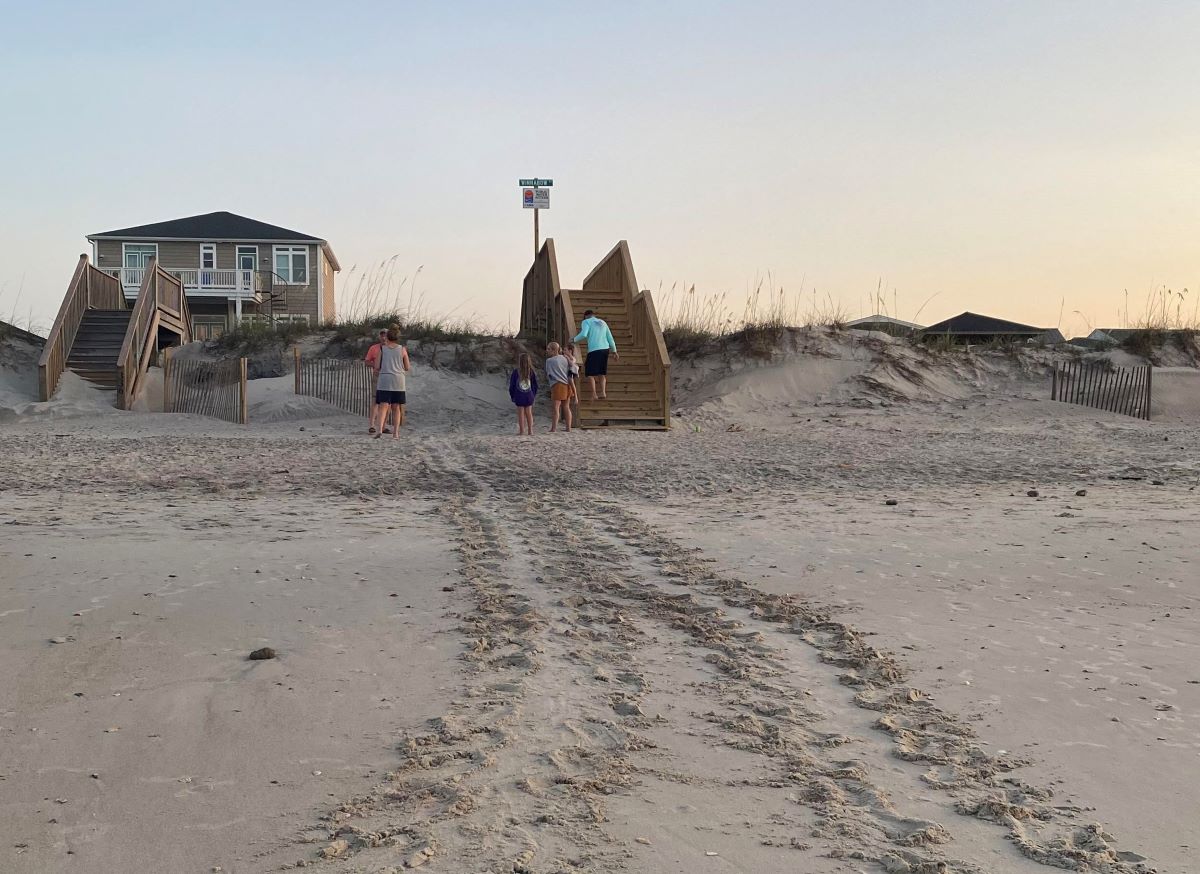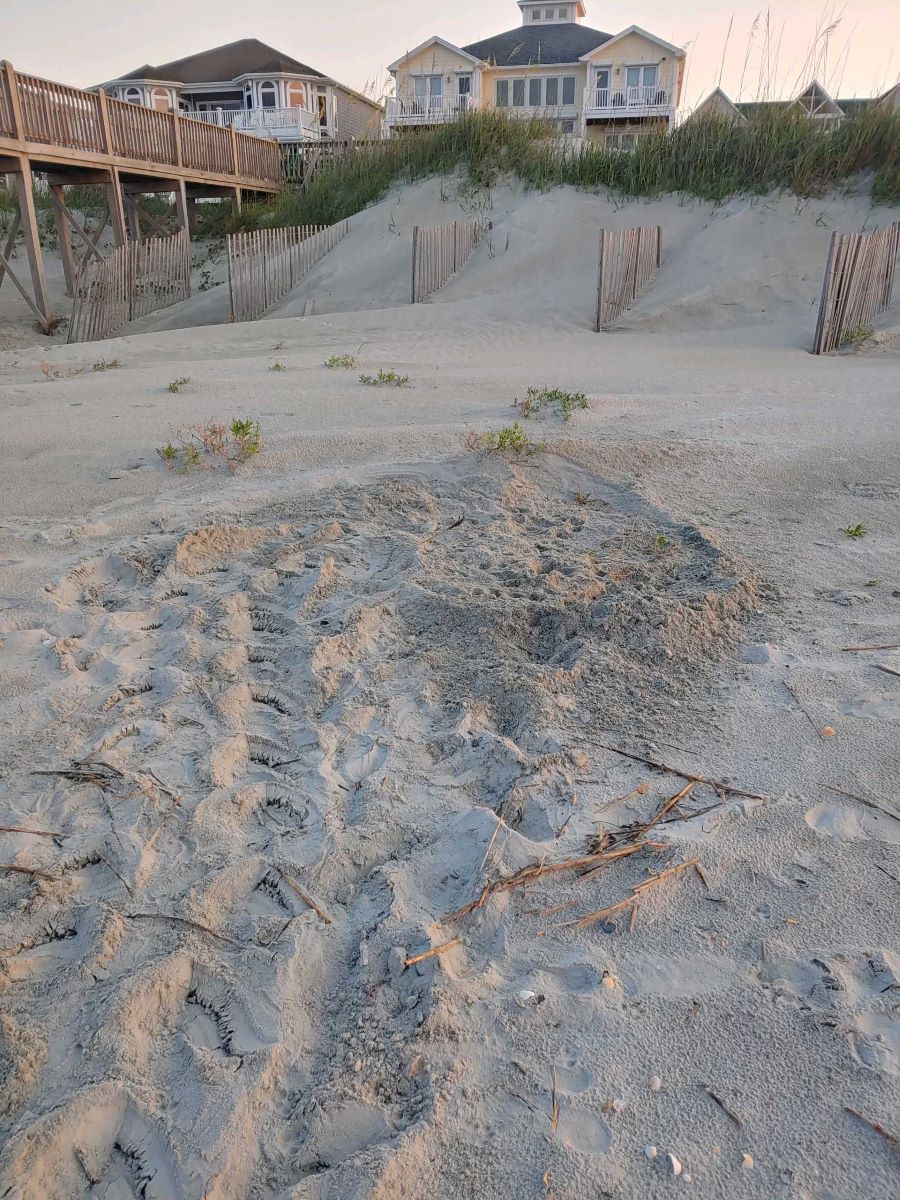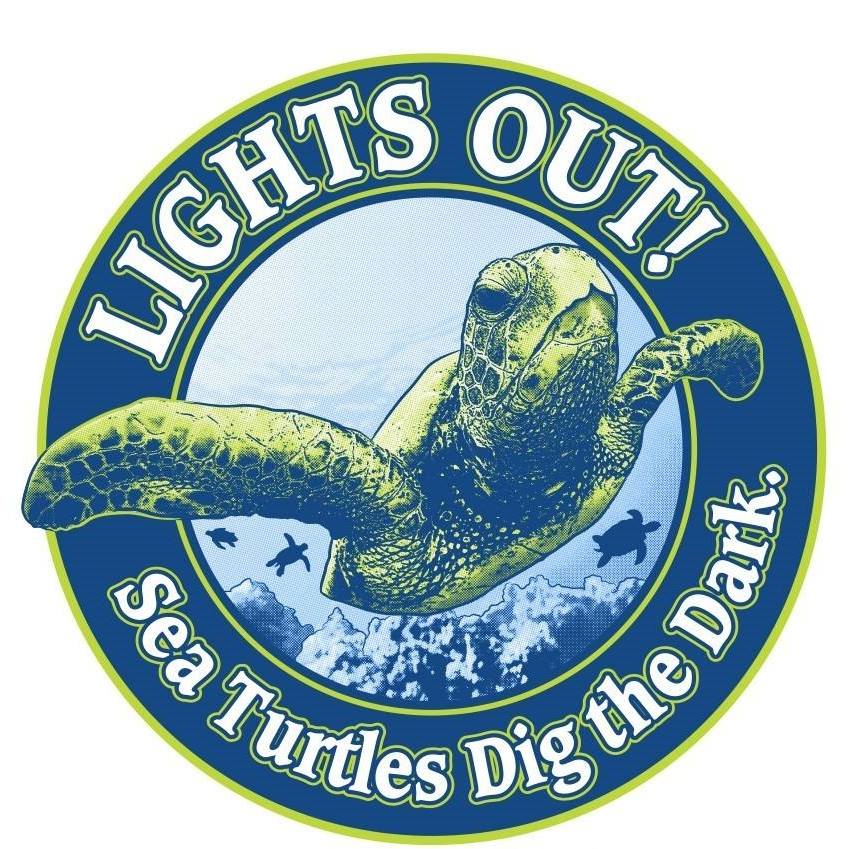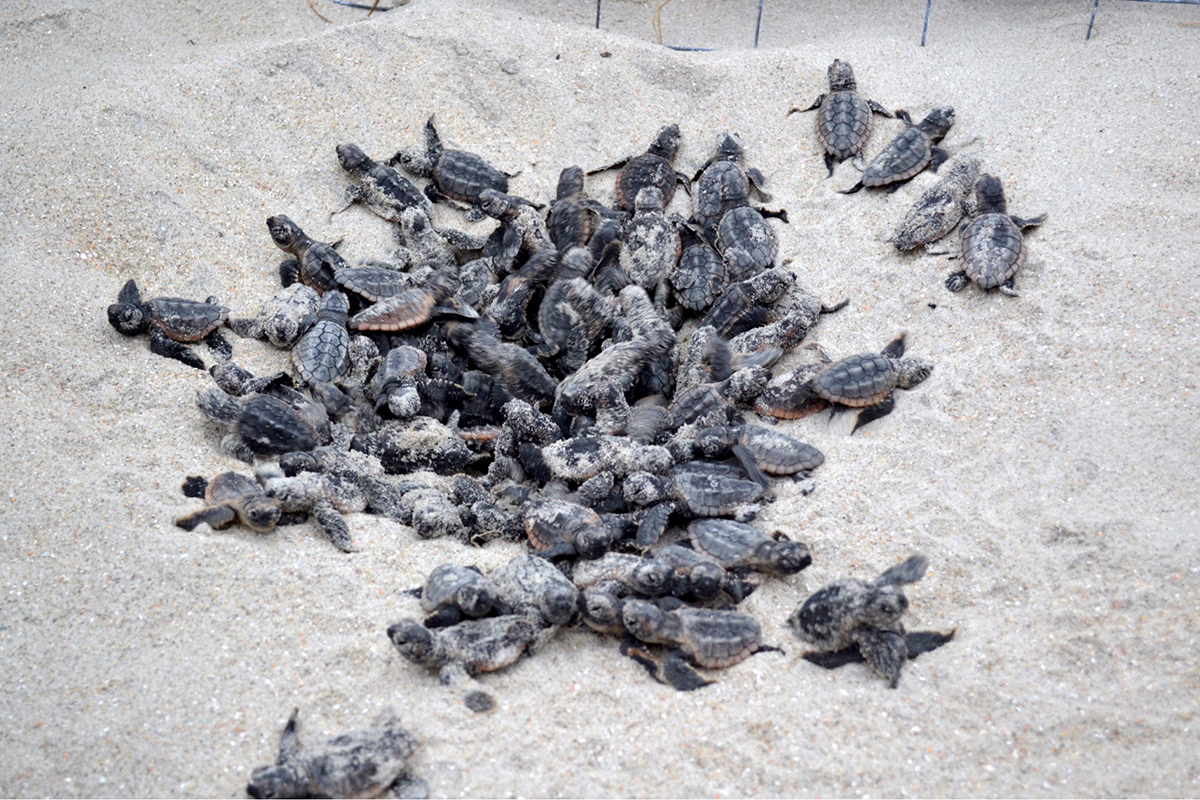
Monday, May 23, is World Turtle Day, established in 1990 by the American Tortoise Rescue based in California to “shellebrate” and protect all species of turtles and tortoises.
For Deb Allen, who moved to Ocean Isle Beach more than a decade ago, every day is turtle day.
Supporter Spotlight
She and her husband Fulton work as island coordinators for the Ocean Isle Beach Sea Turtle Protection Organization and are licensed by the North Carolina Wildlife Commission to handle sea turtles, as required by the Endangered Species Act.
A division of the Museum of Coastal Carolina, a natural history museum on Ocean Isle Beach in Brunswick County, the all-volunteer nonprofit works year-round to protect sea turtles, especially during nesting season, which began this month. Ocean Isle Beach had its first nest of the 2022 season Friday morning.
Volunteers, which are trained by the Wildlife Commission, also transport cold-stunned, sick or injured sea turtles to the Karen Beasley Sea Turtle Rescue and Rehabilitation Center in Surf City.
Allen told Coastal Review that when she and her husband moved to Ocean Isle Beach in 2010, she became a volunteer and has been volunteering ever since. Beginning as a volunteer, she advanced to become assistant coordinator and is now island coordinator.
Supporter Spotlight
“During my time doing this, I was exposed to every aspect,” Allen explained, from rescue to nest certification to watching a turtle lay her eggs to making sure the hatchlings get safely to the water.
“We get to spend time on the beach in the mornings for nest verification and the beautiful summer evenings under the stars, chatting with other volunteers and waiting for babies to emerge from a nest,” she said.
Allen has about 150 volunteers and everybody helps as much as they want in whatever capacity they can. “We have volunteers that do a little bit of everything.”
Nesting season
Allen said Ocean Isle Beach has mostly identified loggerhead turtles, but Kemp’s ridleys, greens and leatherbacks nest along the North Carolina coast.
There were 44 nests with a total of 4,950 eggs on Ocean Isle Beach in summer 2021, but 161 were lost to predators or were submerged. Of those, 3,531 hatched and 287 did not make it. One nest last year was entirely submerged and another nest with 121 hatchlings was killed by foxes.
Every morning during nesting season, volunteers head out on the beach to look for evidence of turtles nesting. Signs of a new nest are flipper tracks in the sand that look like tractor tire marks leading to a body pit in the sand, Allen explained.

If a new nest is discovered, the verification team gently shifts through the sand to find the egg chamber. If the nest is in a safe spot, meaning it will not likely be underwater, it’s left in place, but if it’s in danger of being submerged, volunteers relocate the nest to a safer location.
Each egg is carefully moved one at a time, making sure not to rotate the egg at all. “We don’t want to detach the embryo from the inside of the egg,” she said. The nest is measured after the eggs are removed and volunteers will dig another chamber to the exact measurements. “We’ll relocate the eggs there and then.”
While waiting for the nests to hatch, the nests are marked and protected with mesh.
Kevin Stetson has been the nest verification coordinator with the organization going on four years.
Stetson told Coastal Review Friday that he moved to Ocean Isle Beach from the Midwest after retiring about eight years ago.
He learned about the turtle protection group during a community event and decided to give it a shot. Coming from the Midwest, Stetson never had contact at all with turtles, he said. However, this volunteer effort evolved, for him, from something he thought would be interesting to do during the summer to being more concerned with the health and well-being of sea turtles.

Like Allen, before becoming nest verification coordinator four years ago, Stetson began as a volunteer. First as nest parent and watching the turtles hatch. After seeing the end of the cycle, he decided to see the beginning of the cycle by volunteering to verify nests. Verification involves digging in the sand to find the eggs.
Stetson got back in the groove Friday morning with this season’s first nest. Four volunteers came out to help with the nest, which was in the dune area, and they didn’t have to relocate the nest — their preference.
“For me it’s always a thrill anytime I get a call,” he said. “It was great getting the cobwebs shaken out this first one and get back into the groove of everything.”
He finds it rewarding to know he has a small part in protecting sea turtles. “You’re a small cog in this big wheel, if you will, of helping turtles since they were an endangered species.”
Light pollution
Allen told Coastal Review that it’s important to protect sea turtles to maintain the natural balance in the ocean. “Because sea turtles eat a lot of jellyfish, we want to make sure that there’s a good amount of turtles eating the jellyfish. If there’s an overpopulation of anything in the ocean, it disrupts the balance.”
The biggest challenge for sea turtles in Ocean Isle Beach, or any island beach, is light pollution, she said.
“Last summer we had to classify 287 baby sea turtles as dead just because of light pollution,” Allen said.
The baby sea turtles will move toward lights from a house, the street or even a bright flashlight because that bright light looks like the moon, stars or waves and that’s where they think home is, they’re hard-wired to go back home to the ocean.
If baby turtles end up in the dunes instead of the ocean, they get eaten by predators like crabs or foxes, get stepped on or run over if they’re in the street, or die from the chlorine if they end up in a swimming pool, which she said happened last year to every hatchling in a nest. They went toward a house and ended up in the pool and in the streets.
“It’s a huge problem,” Allen said. The last hurricane wiped out our dunes from Caswell Beach to the South Carolina border, making streetlights, headlights, everything very visible on the street from the beach. “So these hatchlings see all that light and they go right to it.”
Allen said the volunteers do their best to block the light when nests are hatching.
“Sometimes it can’t be done and unfortunately, in rare instances, we have to pick the hatchlings up, put them in a container and take them to a darker area on the beach,” to get them in the water. They’ve had instances where a house a fair distance away was so bright, the hatchlings would get in the water and start swimming but when they see that beach house, they make a U-turn, come back on the beach and go toward that house.
Beachfront residents can take measures to prevent their house from contributing to light pollution.

Allen recommends using sea turtle friendly bulbs, which are an amber color. The turtles don’t see the amber color but they do see the white. Residents can also cover their windows and turn off exterior lights at night if they’re not needed.
“If you’re on the beach, don’t use a bright white flashlight because sea turtles will go toward the white light,” she said.
The organization has a “Lights Out Sea Turtles Dig the Dark” initiative to reduce the amount bright lights that can be seen from the beach. Homeowners, condo owners and associations, property owners associations, hotels and businesses can participate by replacing light fixtures and light bulbs with a sea turtle safer option. The organization has a fundraising program to purchase sea turtle safe light bulbs and light fixtures.
Lights Out sponsorships are $100 are nonrefundable and immediately used to reduce light pollution on Ocean Isle Beach. Checks can be mailed to OIBSTPO, P.O. Box 6524, Ocean Isle Beach, NC 28469.
Public outreach
Allen said there have been changes in the group’s public outreach because of the COVID-19 pandemic.
“We love sharing information about sea turtles, but the North Carolina Wildlife Commission has kind of pulled back the reins since COVID started,” she said, adding that the commission takes measures to keep crowd sizes down to protect the public and the volunteers. But the beach is a good place to learn about sea turtles and the organization’s work.
“If you happen to walk by one of our teams and they’re at a nest, we absolutely encouraged you to go up and ask them any questions you want to ask and they’re going to share any information about that specific nest with you that they can,” she said. Sometimes there won’t be any changes with the nest or the volunteers will say they’re expecting the babies to emerge that night or in a few days.
If babies are emerging from the nest at the time, “we encourage people to respectfully observe all that we’re doing to get the baby safely to the water,” she said.

Sometimes, while the turtles are hatching, Allen said volunteers helping with the nest will ask the public to help, especially with crowd control.
“I have to say our strongest advocates are the kids,” she said. When the hatchlings are about to emerge, volunteers tell the crowd gathered the rules, such as no flash photography or video. The kids “will correct their parents in a heartbeat if they accidentally have a flash on their camera and it’s really quite cool.”
Because the goal is to get the hatchlings to the water, volunteers clear a path for the turtles from the nest to the water, often putting up rope or drawing a line for the public not to cross. They sometimes will ask a 10-year-old to help ask everybody not to cross that line. “They are just excellent advocates. They don’t mind telling people that you’re not supposed to do that, don’t hurt a baby turtle.”
Beginning June 6, volunteers will lead family friendly educational programs about sea turtles nesting on Ocean Isle Beach.
The “Turtle Talk” programs will be at the Ocean Isle Beach Community Center every Monday at 5:30 p.m. and again at 6:30 p.m.
The community center can only accommodate 85 at a time. She encourages people to come early for a seat. “We really love sharing our information about sea turtles,” Allen said.
When visitors come to Ocean Isle Beach, sometimes the only locals they meet are volunteers at a turtle nest, so Allen said they want to make sure to provide educational information and welcome them to the beach.
“Because if we love our sea turtles, then we can get them to love and understand sea turtles. We’ve created another conservationist and that’s our goal,” she said.
Fundraising efforts
To support the all-volunteer organization, there’s the opportunity to Adopt A Sea Turtle Nest on a first-come, first-serve basis. The sponsor will be able to name the nest.
As of last mid-May, 44 nests were already sponsored with the standard sponsorship of $125, Allen said.
The organization is also raising money for the Karen Beasley Sea Turtle Hospital, which are $100. The nonrefundable donation will go directly to the turtle hospital.







